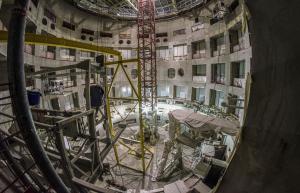Sandblasting
Whether at home or in a nuclear installation, a painting job begins with surface preparation. In the ITER tokamak pit, close to 3,000 square metres of wall need to be sandblasted prior to being coated with thick, smooth, decontaminable "nuclear paint."
Working in two shifts from five suspended platforms, workers have used more than 30 tonnes of abrasive sand to create a rough surface that optimizes paint adherence.


